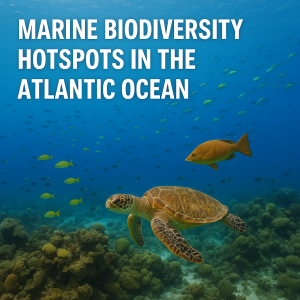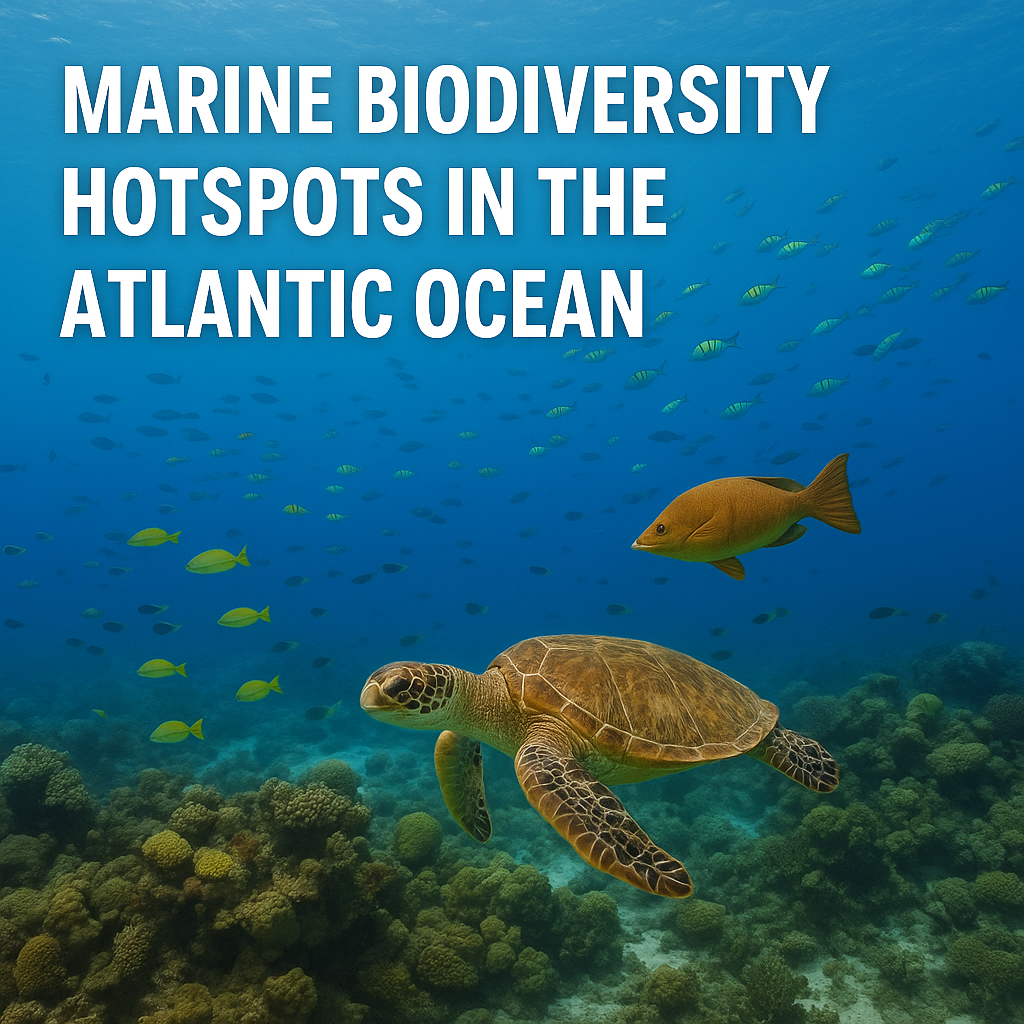 Explore the vital marine biodiversity hotspots in the Atlantic Ocean. Learn about their ecological significance, threats, conservation efforts, and how climate change and maritime activities are impacting ocean life.
Explore the vital marine biodiversity hotspots in the Atlantic Ocean. Learn about their ecological significance, threats, conservation efforts, and how climate change and maritime activities are impacting ocean life.
Why Marine Biodiversity Hotspots in the Atlantic Matter
The Atlantic Ocean is more than just a major shipping highway or a stretch of blue between continents — it is home to some of the world’s most vibrant and critical marine biodiversity hotspots. These regions, rich in life and ecological complexity, sustain not only countless species but also global fisheries, carbon cycles, and coastal economies.
But rising sea temperatures, climate change, pollution, and unsustainable practices are pushing many of these hotspots to the brink. From coral reefs off the Caribbean to the seamounts of the Azores, this article explores why the Atlantic’s biodiversity hotspots matter, the threats they face, and what is being done to protect them.
Understanding What Makes a Hotspot
A marine biodiversity hotspot is an area that supports a high number of species — many of which are endemic (found nowhere else) — and is under significant environmental threat. These zones are often teeming with coral reefs, deep-sea ecosystems, mangroves, and nutrient-rich upwelling zones. In the Atlantic, such regions also overlap with major maritime routes, making their protection a delicate balancing act.
According to the World Ocean Review (2023), over 50% of Atlantic marine species inhabit less than 10% of the ocean’s area — much of it in these biodiversity hotspots.
Key Marine Biodiversity Hotspots in the Atlantic Ocean
The Sargasso Sea
Located entirely within the Atlantic, the Sargasso Sea is unique — it has no coastline. Surrounded by ocean currents, this area is home to vast floating mats of Sargassum seaweed, which provide shelter and spawning grounds for fish, turtles, and invertebrates.
- Significance: Nursery habitat for species like the European and American eel, and juvenile sea turtles.
- Threats: Sargassum blooms fueled by pollution and climate change, plastic accumulation, shipping traffic.
Supported by the Sargasso Sea Commission and UNESCO, international efforts have emerged to give this open-sea hotspot legal protection despite jurisdictional complexities.
The Caribbean Coral Triangle
While often associated with tourism, Caribbean coral reefs (including those around the Bahamas, Cuba, and Lesser Antilles) are biodiversity engines. They host more than 65 species of stony coral and over 500 species of reef fish.
- Significance: Supports millions through fisheries and coastal protection.
- Threats: Coral bleaching, rising sea temperatures, overfishing, ship groundings, invasive lionfish.
Initiatives such as the Caribbean Challenge Initiative and Coral Restoration Foundation are actively restoring reef habitats through science-based coral farming.
The Azores and Mid-Atlantic Ridge Seamounts
The Azores, a Portuguese archipelago, sits on top of submerged volcanic seamounts that rise from the Mid-Atlantic Ridge. These underwater mountains are hotspots for deep-sea corals, sponges, and migratory species like whales and sharks.
- Significance: Critical for biodiversity connectivity and migratory corridors.
- Threats: Deep-sea mining, bottom trawling, climate-induced oxygen loss.
Recent studies in Marine Policy (2023) highlight the role of Marine Protected Areas (MPAs) around the Azores in safeguarding vulnerable marine ecosystems.
The Benguela Current Region (South-East Atlantic)
Stretching from Angola to South Africa, the Benguela Current is one of the world’s most productive upwelling systems. It supports rich fisheries and iconic species like the African penguin and Cape fur seal.
- Significance: Major economic driver through fisheries.
- Threats: Overfishing, oil drilling, climate-induced upwelling shifts.
The Benguela Current Commission, backed by UNDP and GEF, is a cross-border conservation and sustainable use platform for Angola, Namibia, and South Africa.
The Grand Banks and Flemish Cap (North-West Atlantic)
Located off Canada’s Newfoundland, these shallow banks are hotspots for cod, haddock, halibut, and deep-sea corals.
- Significance: Formerly one of the world’s richest fishing grounds.
- Threats: Historical overfishing, bottom trawling, warming waters.
Canada has taken major strides via its Oceans Protection Plan and MPAs designated under DFO Canada to limit harmful fishing methods.
Key Developments Driving Biodiversity Protection
Marine Protected Areas (MPAs)
Atlantic nations have expanded MPAs to protect fragile habitats. As of 2023, over 28.4% of the North-East Atlantic’s marine area is protected under the OSPAR Convention, according to the European Environment Agency.
Examples include:
- The Charlie-Gibbs Fracture Zone MPA: A deep-sea sanctuary co-managed by Iceland, Ireland, and the EU.
- Brazil’s Fernando de Noronha Marine Park: A critical Atlantic hotspot with strict no-take zones.
Satellite Monitoring and Maritime Surveillance
Technologies like AIS (Automatic Identification System) and Inmarsat’s Fleet Safety help monitor vessel activity in sensitive areas. Combined with platforms like Global Fishing Watch, authorities can detect illegal fishing in real time.
Blue Economy and Biodiversity Finance
Global funds are emerging to finance nature-based solutions. The Blue Nature Alliance, for example, aims to protect 30% of the ocean by 2030. Atlantic-focused projects have received support under GEF, UNDP Ocean Innovation Challenge, and EU Horizon Blue Missions.
Maritime Activities and Their Impact
Shipping Lanes and Port Expansion
Shipping traffic can disrupt migratory species, introduce noise pollution, and cause fatal strikes — especially in whale-rich regions like the Bay of Biscay and U.S. East Coast.
According to the IMO and NOAA, vessel slow-down programs have reduced whale strikes by up to 85% in designated Seasonal Management Areas.
Deep-Sea Mining
Exploration licenses for polymetallic nodules and seafloor massive sulfides have been issued by the International Seabed Authority (ISA) in parts of the Mid-Atlantic. Deep-sea habitats are highly sensitive, and recovery may take centuries.
Fisheries and Bycatch
Unregulated bottom trawling can devastate seamount ecosystems. Species like deep-sea coral grow just 0.5–1 cm per year, making them extremely vulnerable. Organizations like NAFO (Northwest Atlantic Fisheries Organization) have enforced closures to protect vulnerable marine ecosystems.
Case Studies: Biodiversity and Protection in Action
Canada’s Marine Spatial Planning (MSP) in Atlantic Waters
Canada is implementing MSP in the Atlantic to balance economic uses and conservation. Through DFO’s Atlantic Zone Monitoring Program and Indigenous-led partnerships, species like Northern bottlenose whales are receiving greater legal protections.
Cabo Verde’s Community-Based Marine Management
In this West African island state, local fishers manage marine zones using traditional ecological knowledge (TEK). This approach has helped sustain populations of sea turtles and groupers.
High Seas Treaty and the Atlantic
The 2023 UN High Seas Treaty (BBNJ Agreement) aims to protect biodiversity beyond national jurisdictions. If ratified by Atlantic nations, it could enhance governance of hotspots like the Sargasso Sea and Mid-Atlantic Ridge.
Frequently Asked Questions (FAQ)
What is a marine biodiversity hotspot? A marine biodiversity hotspot is a region rich in species (many unique) and under threat, requiring urgent conservation. In the Atlantic, these include coral reefs, seamounts, and upwelling zones.
Why are coral reefs important in the Atlantic? They support fisheries, tourism, shoreline protection, and are home to thousands of marine species. Their loss would affect both biodiversity and human livelihoods.
What threats do Atlantic biodiversity hotspots face? Key threats include climate change, ocean acidification, overfishing, deep-sea mining, and maritime traffic.
How do MPAs help marine biodiversity? Marine Protected Areas reduce human pressures and allow ecosystems to recover, improving fish stocks and protecting habitat.
Can shipping affect biodiversity? Yes. Ship noise disrupts marine life, and vessels may strike large species like whales. Ballast water can also introduce invasive species.
What is being done to protect the Sargasso Sea? The Sargasso Sea Commission, supported by Atlantic nations and NGOs, is advocating for international agreements to regulate activity in this unique high seas area.
Is deep-sea mining already happening in the Atlantic? As of 2025, no commercial operations are underway, but exploration licenses have been issued. Conservationists are urging a moratorium until stronger environmental safeguards are in place.
Conclusion: Charting a Course Toward Conservation
The Atlantic’s biodiversity hotspots are blue beacons of life — from the turtle nurseries of the Sargasso Sea to the coral cities off Brazil and the penguin colonies along South Africa. But these ecosystems are not infinite.
With climate change, overexploitation, and development pressures, the need to safeguard marine biodiversity has never been greater. Through effective policies, local stewardship, international treaties, and smart maritime practices, we can ensure that the Atlantic remains not just a shipping corridor — but a thriving living ocean.
Protecting biodiversity isn’t just an environmental goal — it’s a maritime necessity.
References
- World Ocean Review (2023). Marine Biodiversity Hotspots
- Marine Policy Journal. (2023). Seamount Conservation in the Atlantic. Elsevier.
- NOAA (2024). Atlantic Marine Species and Shipping Lanes
- UNCTAD Review of Maritime Transport (2023). Maritime Traffic and Biodiversity
- IMO. (2024). Shipping and Whale Conservation
- Global Fishing Watch. (2025). Fisheries Monitoring
- European Environment Agency. (2023). MPA Coverage in Atlantic Waters
- Inmarsat Maritime. (2024). Fleet Safety and Environmental Monitoring
- Marine Pollution Bulletin (2023). Plastic Accumulation in the Sargasso Sea. Elsevier.
- Coral Restoration Foundation. Coral Rehabilitation Projects
- Sargasso Sea Commission. Conservation Efforts
- DFO Canada. Oceans Protection Plan
- Benguela Current Commission. Upwelling Management
- UN High Seas Treaty (2023). BBNJ Agreement Summary

